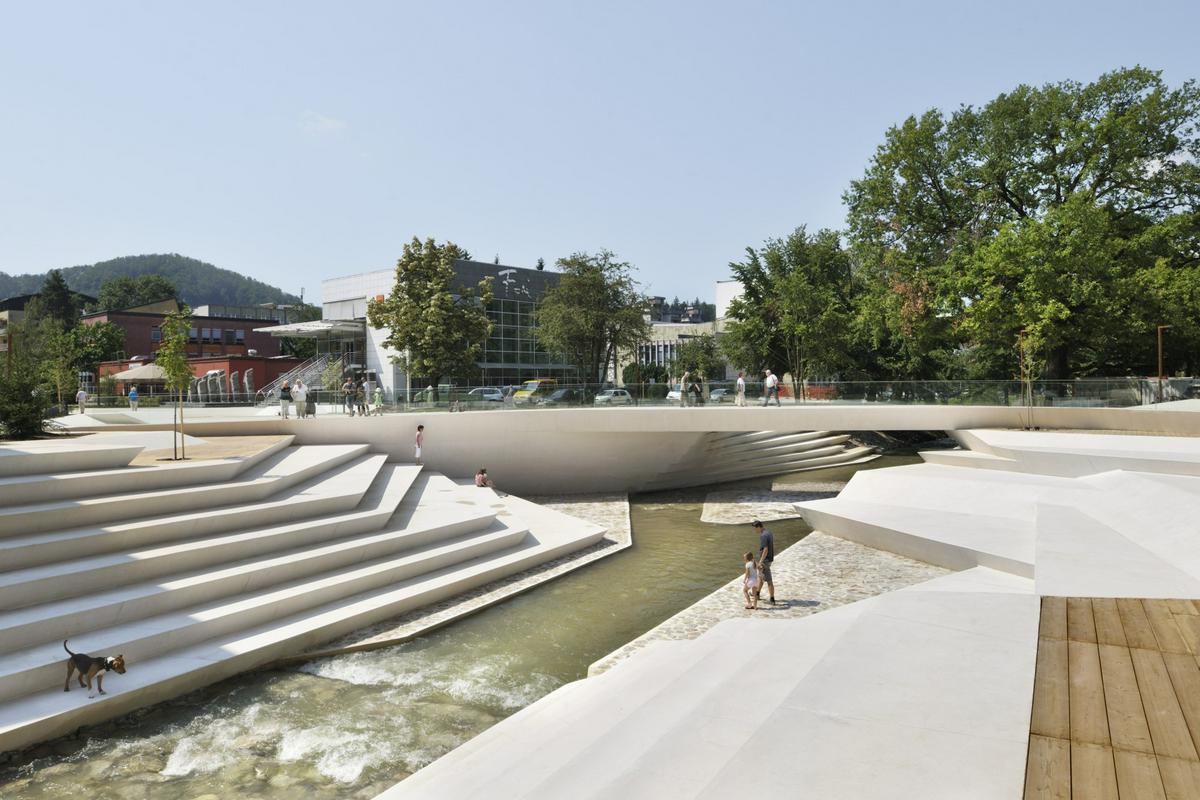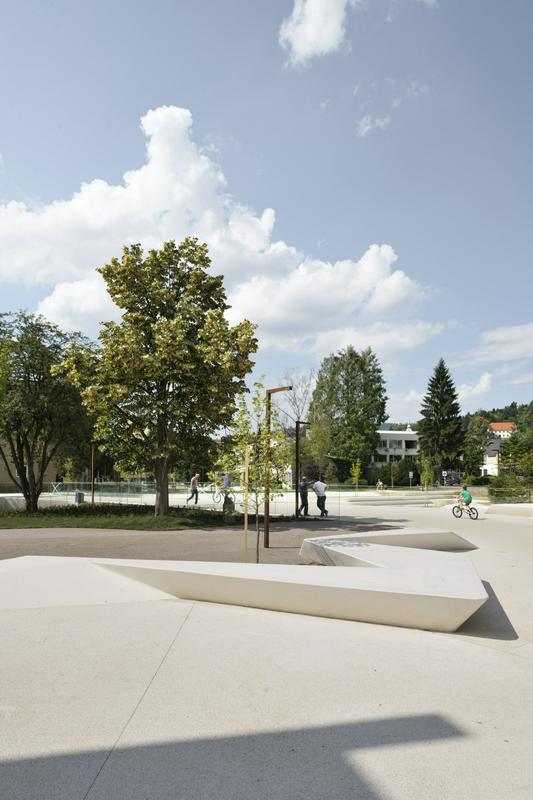

by the ENOTA firm and the Bicycle Bridge across the River Sava in Bohinjska Bistrica by the firm DANS arhitekti are among this year’s award winners of the Architizer A+Awards programme. The Brežice Wine Cellar by the architecture office Studio abiro was also placed very highly.
Architizer A+Awards reward major achievements in architecture around the world and their positive impact on everyday life. Architizer.com is the biggest global community of architects on the internet, and has more than a million views a month.
Award winners are selected by a jury composed of 300 distinguished figures in various fields, such as fashion, publishing, design, real estate development and technology. This year’s winners were honoured in a ceremony in New York.
Promenada Velenje
The Promenada Velenje City Centre Pedestrian Zone project of 2014 won an award in the public parks category. The initiative to repurpose the former road through the city of Velenje, which was converted into a pedestrian zone some time ago, was launched by the Municipality of Velenje, which carefully prepared the entire project, while the conceptual design for the renovation of the promenade was drawn up by the ENOTA architecture firm, which had already won an Architizer A+Award the previous year for its Ptuj Performance Centre.
So what was the aim of the Promenada Velenje project? "Since this had once been a road, in our opinion the paved surface was too wide to be user-friendly. We therefore narrowed the pathway and shaped it organically. This encourages people to stop along the way and stick around there for longer, and at the same time we obtained more green surfaces, which in this former garden city are lacking because of the expanding car parks," explains architect Milan Tomac of the ENOTA firm. In the place where the road once traversed the River Paka, they created an area that brings the aquatic element closer to visitors, an element that had previously been neglected.
Promenada - the main event axis of the city
With the transformation, the Promenada is turning into a main event axis of the city, its centre being placed into the new amphitheatre along the river. The river Paka is a torrential river, which means that its watercourse swells up significantly a few times a year, but remains relatively shallow at all other times. As a consequence, the riverbed is very deep and until now, the river, which is an attractive element of any city, flowed out of sight somewhere down below. The wide bridge also meant that anyone walking across it had a hard time seeing the river at all. By narrowing the bridge and placing it off the former axis, the space for the construction of an amphitheatre, which slowly slopes down towards the river surface, is recovered. The attractive amphitheatre by the river, with the new bridge serving as its backdrop, becomes the centre of the activity in the city, and the river may once again claim an important spot in the townspeople's consciousness.
Where the pathway ends there is now a covered car park with twice the capacity of the original parking lot that stood there. Cars are now hidden amongst the greenery and behind a semi-transparent facade. At the car park exit there are some public service facilities, including bathrooms. The roof of this part of the structure is designed as a stage for summer open-air performances.
The ENOTA team is happy that their arrangement has been well received among users, and that the new spaces are being used in the way they imagined. The fact that their work is outstanding is proven by the awards they have received. "All the awards we receive are first and foremost confirmation that we are doing the right thing. The client has similar benefits, but still, at a time when the majority of investments are beset by all kinds of scandals, an award puts the project in a more friendly and more positive light," says Milan Tomac of ENOTA.
Bicycle Bridge across the River Sava in Bohinjska Bistrica
The Bicycle Bridge across the River Sava, constructed in 2013 by the DANS architecture firm, won an award in the transport and infrastructure category. "This award amidst global competition is one more confirmation of the quality of modern Slovenian architecture. It is important for us that our architectural approach is recognised, since this serves as an incentive for the future, for new orders and new success for us and our clients. Even more important than the award is the fact that the bridge is a source of pride, joy and aesthetic enjoyment for all the local people and visitors," say the successful DANS architects. The Bicycle Bridge across the River Sava in Bohinjska Bistrica project also won them a First National Award for the Best Wood Construction 2013.
How did the idea for the project come about? "The construction of any bridge involves three determining elements: the river spanned by the bridge, the two banks that it connects and the path leading over it. New spatial relations are being established, and a pathway has appeared where there was none. It sounds simple, but it involves many layers of meaning. For this reason people have ascribed special importance to bridges since the earliest times," explain the architects.
The bicycle bridge links the two banks of the River Sava by the confluence of the Sava and its tributary, the Bistrica, in a recreational and bathing area by the Danica campsite, which is attached to the recreational area next to the town and river. The bridge was created as part of the picturesque cycle path from Lake Bohinj to Bohinjska Bistrica, which is a municipal and tourism centre. The new bridge spans the river in a long, elegant arch, which rises over the beach supported by two piers, whose design offers an abstract reproduction of rock boulders. The length and height of the bridge are such that it appears light and trim. On both sides of the river the arch rests on low grassy inclines.
New scope for use of the riverside space
The arrangement of the embankments is part of the co-natural landscaping of the riverbanks, and offers new scope for use of the riverside space. The raised wooden bridge allows free passage underneath for bathers along the beach. The slopes are designed so as to signify a design and functional complement for the beach. They have been arranged as grassy earth embankments running parallel to the stream. Between the river and the embankment is space for a riverside beach that has always been here. Here, at the confluence, the space opens up, with a wide river shoreline of rounded white stones lining the turquoise-blue water.
The architecture of the bridge adheres to the principles of sustainable construction, whereby the construction site is changed as little as possible, and with the least possible input of labour and materials used we cause the least possible damage to the environment. At the same time the design incorporates the rhetorical and symbolic potential of modern architecture. We are convinced that tradition does not exclude progress, and that by using modern technology it is possible to design innovative local adaptations and fun interpretations of vernacular architecture.
Brežice Wine Cellar
To date, Studio abiro has competed twice in the Architizer A+Awards, and both times it was placed among the five finalists: in 2015 in the sports centre category with its Planica Ski Jumping Centre, where together with landscape architects Studio AKKA it won 1st prize in the public voting and in 2016 in the residential interiors category with its Wine Cellar microproject, which did not win a prize, but was nevertheless a success in that such a small project (25 m2) was ranked among the five finalists.
The public voting award last year for the Planica Ski Jumping Centre was itself a really nice confirmation of our work, and also made us internationally known and recognised. The Architizer Awards have a global significance, with architects from all over the world applying. It can of course compare to sporting wins in world championships. Where the Planica Ski Jumping Centre could expect to create more of a stir because of the facilities offered, the location and the natural setting, in truth we were all the more pleased with this year’s ranking among the finalists for the tiny Wine Cellar project. Especially since this involved very direct architecture, without any complicated details, expensive materials and magnificent pictures.
The Wine Cellar project involved the renovation of the basement in a residential building as the final phase of the complete renovation of a home in the Posavje region. In the past the space served for the maturing and storage of home-made wine, when the homestead was still surrounded by vineyards on the southern and western slopes. Today the space is intended for socialising and to commemorate the wine tradition of the home.
Two basic materials were involved – reinforced concrete from the existing construction elements and massive oak timbers. In the renovation, all the existing bearing structures and columns were finely sanded, then a console counter in the same finish was hung from them. In this way, three periods of concrete elements were unified by the design, and differences between them can only be noticed in the details. The floor of the cellar is also poured concrete with a smooth finish. The wall panelling, shelves and dresser are made of thoroughly brushed oak. Just as sanding reveals the rich structure of poured concrete, brushing massive wood elements enhances their texture, quality to the touch and resilience. The furniture added to the space – bench, chairs and table – adheres to the same design principles of simplicity and functionality, and use light joined panels of birch and alder.
A special feature of the space is the light wall of 200 concrete waves with back lighting. The concept stems from the desire that despite the conditions in the space no longer being suitable for storing bottled wine, it does not lose its memory of that original purpose.
What seems on the surface a very simple project is in truth full of tiny details, sources of light, reflections and angles of view. "The rich variety of experience thus contributes to expanding the perceived size of the space, which measures just 20 m2, just as that number of guests were able to have a pleasant gathering there on the opening," say the Studio abiro architects.

































































